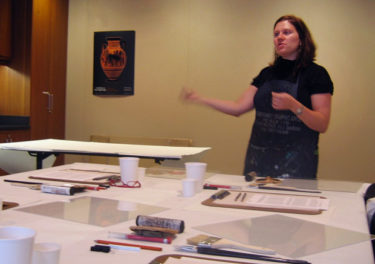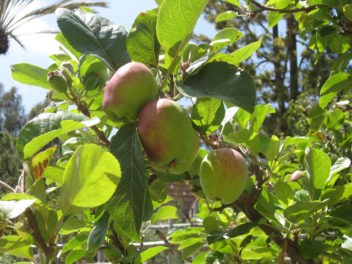Halloween will no doubt be different this year but, even so, decorating pumpkins at home is a fun and safe way to celebrate. It’s also a great excuse to push your creative limits and invoke your inner artist.
Over the years, the Getty Villa has held pumpkin carving contests among our very talented interns. Some of the antiquity-inspired designs are definitely prize-worthy. Below, we offer a few Getty-inspired ideas to jazz up your pumpkin carving.
1. Cronus

Back in 2011, education graduate intern Mairin Kerr made a pumpkin representing Cronus throwing up his children Hestia, Demeter, Hera, Hades, and Poseidon, which are identified by their Olympian attributes. The rock in the middle represents Zeus. For those unfamiliar with the myth, Cronus, King of the Titans, was afraid one of his children would kill him, as he did his father. So he swallowed his children. His wife, Rhea, got tired of losing her children and disguised a rock as her son Zeus for Cronus to swallow. Zeus was taken away to the island of Crete and when he grew up he disguised himself as Cronus’s cupbearer and added a potion to his drink to make him vomit all of his siblings. Zeus was reunited with his powerful siblings and together they overthrew their father.
For more pumpkin carving inspiration from the mythology of Zeus, check out these works of art:

Votive Relief to Zeus Meilichios, about 330–320 B.C., Greek (Attica). Marble, 8 1/4 × 6 7/8 in. The J. Paul Getty Museum, 73.AA.81. Digital image courtesy of Getty’s Open Content Program

Head of Seated Zeus, 1st century B.C. Dolomitic marble, with added metal wreath, 20 11/16 × 14 9/16 in. The J. Paul Getty Museum, 72.AA.130. Digital image courtesy of Getty’s Open Content Program
2. The Judgment of Paris
In 2015, the interns decided to do a single mythology theme: “The Judgment of Paris,” a contest between the three most beautiful goddesses—Aphrodite, Hera, and Athena—for a prize of a golden apple. Zeus appointed the Trojan prince Paris to judge the contest. Paris chose Aphrodite as the winner since she promised him the most beautiful woman in the world, Helen, which eventually led to the Trojan war.

Pumpkins left to right: “Aphrodite” by Ellie Ohara (antiquities conservation Intern), “Medusa to represent Athena” by Yezibel Ruiz (registrar intern), “Hera” by Emma Sachs (antiquities curatorial intern), and “Paris/Shephard Prince with mini golden pumpkin/apple of discord” by Rachel Spradley (exhibitions intern)
Want more inspiration from the Judgment of Paris? Check out these works of art:

This vase depicts the Judgment of Paris. Euoboean Black-Figure Neck Amphora, about 570–560 B.C., Greek. Terracotta, 14 × 9 1/8 in. The J. Paul Getty Museum, 86.AE.52. Digital image courtesy of Getty’s Open Content Program

Paris, probably 100–200, Roman; and before 1767, Italian. Marble, 52 3/8 in., 470 lb. The J. Paul Getty Museum, 87.SA.109. Digital image courtesy of Getty’s Open Content Program
3. Medusa

Hand Mirror Decorated with the Head of Medusa, 500–480 B.C., Roman. Bronze, 7 15/16 × 5 7/8 in. The J. Paul Getty Museum, 96.AC.109. Digital image courtesy of Getty’s Open Content Program

In 2014 and 2017, curatorial interns Jacquelyn Clements and Ruth Allen made pumpkins inspired by the Villa’s Hand Mirror with the Head of Medusa. Medusa, a gorgon or monster in Greek mythology, had the power to turn anyone into stone with just a stare. The head of Medusa was considered apotropaic, possessing the ability to ward off evil and bad luck, and placing her image on the other side of a mirror was believed to repel unkind or envious glances.
Find more inspiration in this artwork depicting Medusa:

Medusa, 1911, Vincezo Gemito. Partially gilt silver, 9 1/4 in. The J. Paul Getty Museum, 86.SE.528. Digital image courtesy of Getty’s Open Content Program
4. Snarling Lion


Black-Figure Kylix, about 540 B.C., attributed to Hunt Painter (Greek (Lakonian). Terracotta, 3 7/16 × 6 11/16 in. The J. Paul Getty Museum, 86.AE.51. Digital image courtesy of Getty’s Open Content Program
Another pumpkin from 2017 by conservation intern Julia Commander was inspired by the Villa’s black-figure Kylix, or cup with a snarling lion. This cup was used for drinking wine at symposiums or male drinking parties in ancient Greece. The painter created an animated lion by having its head turned back and its paw raised while also creatively filling the circular interior. The circular shape also fits perfectly on a pumpkin.
We loved this recreation of the lion so much that we created a lion stencil to try out at home.
Animals can be found throughout Greek art; let the following horse, bird, and lion inspire your own pumpkin design:

Black-Figure Amphora, about 570–560 B.C., attributed to Painter of Acropolis 606. Terracotta, 14 3/8 × 10 1/2 in. The J. Paul Getty Museum, 56.AE.72. Digital image courtesy of Getty’s Open Content Program

Funerary Lion, about 310 B.C., Greek (Attica). Marble, 43 1/8 × 10 7/8 in. The J. Paul Getty Museum, 73.AA.121. Digital image courtesy of Getty’s Open Content Program
5. The Villa’s Outer Peristyle Garden

Inspired by this inventive recreation we turned to the design elements at the Villa to create a painted pumpkin. A geometric patterned floor of slate and limestone in the Villa’s outer peristyle garden became inspiration for the pumpkin.


We loved the graphic elements of the floor’s pattern, and how it only required one color of paint! The pattern could be repeated on the pumpkin but gained its own personality by adhering to the natural contours of the object’s irregular shape.
Using the natural lines on the pumpkin as the guide, we created a grid of three rows of triangles before filling them in. The final pumpkin was inspired by antiquity, but uniquely our own.
Below are a few other design elements from the Villa for inspiration:


Don’t forget to add a little something spooky because, according to the ancients, evil scares evil!




This is soooooo cooooool!
I love the Villa and the Creativity it inspires!
God (or gods and goddesses) when will you re-open!!!!!
The carved pumpkins are amazing, but I also enjoyed the art that inspired them.
Always enjoy the Getty emails with all the beautiful artworks including the pumpkins thank everyone for their work especially during Covid. Can’t wait to return to the villa.